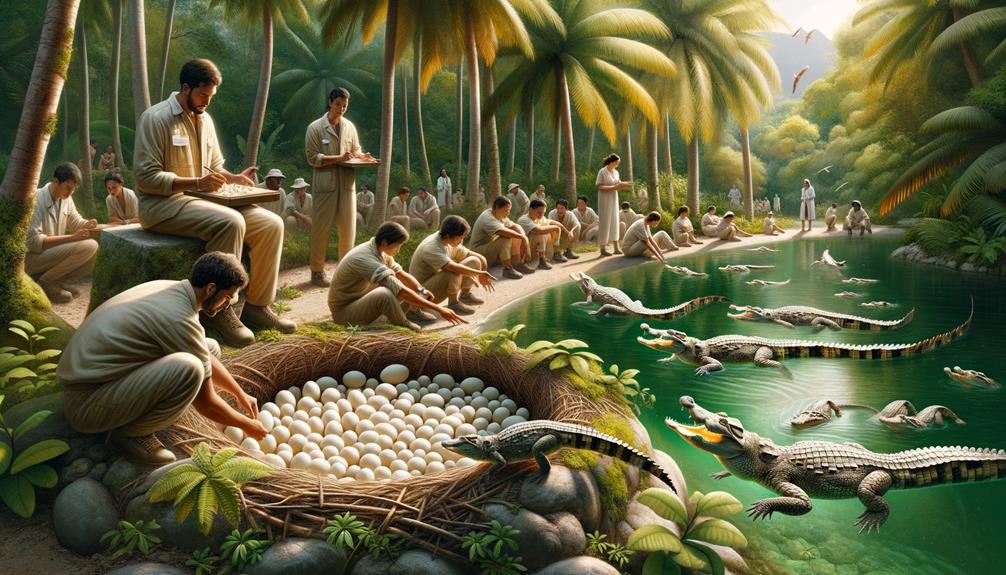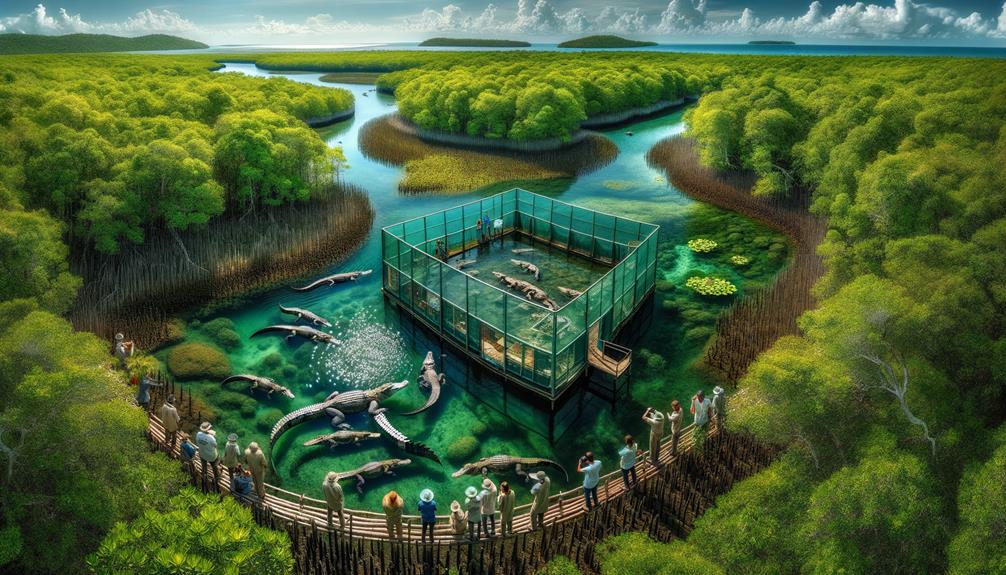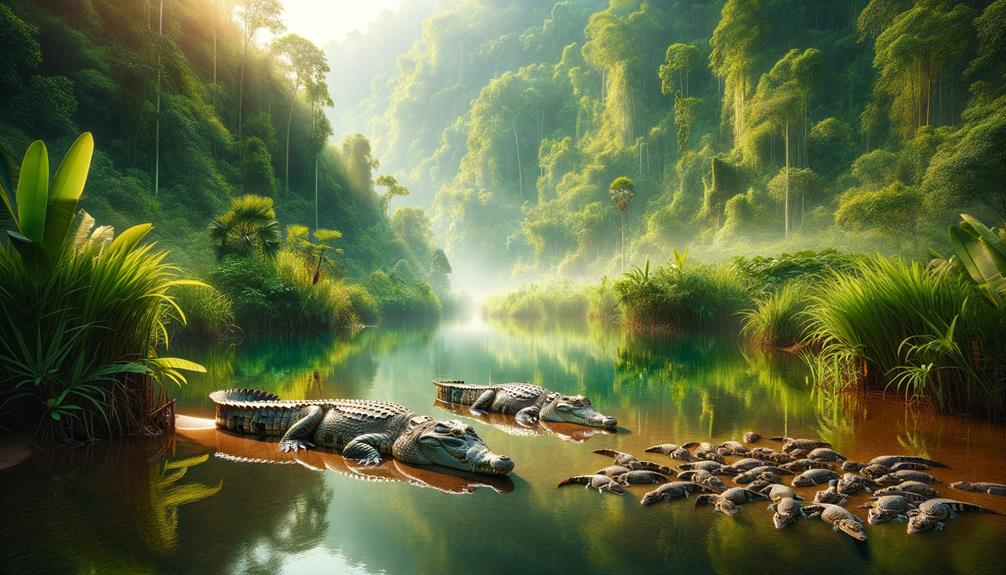Captive breeding programs for the critically endangered Philippine crocodile are vital for the species' survival and genetic diversity, with fewer than 100 individuals remaining in the wild. Collaborative efforts between local and international institutions, such as Cologne Zoo, play a crucial role in this endeavor. Young crocodiles born in captivity adapt better to their natural habitat and are released into protected areas. Interestingly, these crocodiles have exhibited new behaviors, like climbing steep slopes, which could lead to changes in monitoring techniques. Ongoing breeding and conservation initiatives continually evolve to maximize their effectiveness. These initiatives offer a fascinating glimpse into the efforts to preserve this species.
Key Takeaways
Captive breeding projects play a vital role in preserving the genetic diversity of the critically endangered Philippine crocodile. In controlled environments, juvenile crocodiles grow stronger and more resilient, resulting in higher survival rates when released into protected areas. Collaborative efforts between local conservation groups and international institutions, such as Cologne Zoo, have led to successful breeding and reintroduction programs. Observations of new behaviors in captive-bred crocodiles have prompted the development of updated survey techniques to locate and monitor elusive populations more effectively. Advanced monitoring tools, including acoustic devices and drones, have significantly improved the effectiveness of conservation strategies.
Importance of Captive Breeding
Captive breeding is vital for the Philippine crocodile's survival, with fewer than 100 individuals remaining in the wild. Conservation breeding projects in the Philippines and internationally are crucial for preserving the species' genetic diversity and long-term viability. By maintaining a population of captive-bred crocodiles, we can ensure a safety net against extinction due to habitat loss, hunting, or natural disasters.
Releasing captive-bred juveniles into protected areas has proven more effective than releasing adults. Young crocodiles adapt quickly to their surroundings and develop natural behaviors necessary for survival. This approach increases their chances of thriving and reproducing in the wild, contributing to the population's recovery.
Collaborative efforts between Philippine conservation groups and international institutions, such as the Cologne Zoo, have been instrumental in these initiatives. Repatriating captive-bred crocodiles supports in-situ conservation, reintegrating them into their natural habitats. These projects demonstrate that concerted effort and international cooperation can make a significant difference for the Philippine crocodile, helping it reclaim its place in the wild.
Breeding and Development

Building on the significance of captive breeding, it's fascinating to see how Philippine crocodiles adapt and develop once reintroduced into their natural habitat. On Siargao Island, these reptiles have not only survived but also reproduced, with juvenile crocodiles showing remarkable adaptability compared to adults, making them ideal for release. This focus ensures that young crocodiles can develop natural traits and behaviors crucial for their survival.
Captive breeding programs carefully plan the release of these juveniles to maximize their chances of thriving. By releasing them at a young age, they can integrate into their ecosystems more smoothly. Citizen scientists have even found nests with eggs in the wild, indicating that these reintroduced crocodiles are breeding successfully.
The Philippine government, Cologne Zoo, and other conservation groups have collaborated to achieve this success. Their joint efforts guarantee that the captive breeding and reintroduction programs are long-term solutions for the conservation of the Philippine crocodile. This cohesive strategy is vital in fostering a self-sustaining population in the wild, ensuring a secure future for generations of crocodiles.
New Behaviors Observed

Observations of captive-bred Philippine crocodiles have revealed surprising new behaviors, such as climbing steep slopes and scaling limestone walls, which offer fresh insights into the species' adaptability. These reptiles can navigate terrain previously thought impassable for them, with some even scaling 16-meter-high slopes and 50-degree limestone walls.
Interestingly, these crocodiles also exhibit a shift in their breeding season, with eggs found in nests as late as November, deviating from the typical March to July period. This finding expands our understanding of their life cycle and suggests they have more flexible reproductive strategies.
These new behaviors mean we need to reassess our current survey techniques. Traditional methods might overlook populations in new habitats, particularly in elevated or rugged terrains. By updating our approach, we can more accurately locate and monitor these elusive creatures.
Further study of these behaviors will help us develop more effective conservation strategies, ensuring we protect the Philippine crocodile better. The adaptability shown by these captive-bred individuals is promising for their survival in the wild.
Habitat Protection Strategies

Effective habitat protection strategies are vital for the survival of the critically endangered Philippine crocodile. To ensure the species' survival, a multifaceted approach is necessary, including the establishment of protected areas, community-based conservation efforts, and in-situ interventions. The Philippines has designated several protected areas and sanctuaries to safeguard the species' dwindling natural habitat. For example, the Divilacan River, Ligawasan Marsh, and Dalupiri Island have been declared protected habitats, providing a refuge for these vulnerable reptiles.
Local communities have played a crucial role in establishing crocodile sanctuaries and head-start programs in municipalities like San Mariano in Isabela Province. These initiatives aim to boost population recovery by creating safe environments where young crocodiles can grow before being reintroduced to the wild.
The National Philippine Crocodile Recovery Team, established in 2000, has been instrumental in developing and implementing the National Recovery Strategy. This strategy emphasizes ongoing collaboration between government agencies, conservation organizations, and local communities. Despite these concerted conservation efforts, habitat loss and degradation remain significant threats. Therefore, a sustained and coordinated approach is necessary to protect the natural habitats crucial for the survival of this endangered species.
Survey Techniques Enhancements

I've come to realize that our current understanding of Philippine crocodile habitats and behaviors requires a major overhaul in our survey techniques. We need to adopt more effective data collection methods, cutting-edge monitoring technologies, and refined survey protocols to accurately track and study these reptiles. This will provide us with more accurate insights into their population dynamics and habitat utilization.
Improved Data Collection Methods
To better understand the elusive Philippine crocodile, we need to refine our survey techniques by incorporating advanced data collection methods and local ecological knowledge. By doing so, we can gain a deeper understanding of their population, habitat use, and reproductive patterns.
Recent discoveries, such as crocodiles climbing up steep hillsides and limestone walls, highlight the need to reassess our current survey methods. We must adapt to these newfound behaviors to accurately estimate their population and habitats. Citizen scientists have contributed valuable data by finding crocodile nests with eggs in wetland environments, providing insight into their breeding habits and life cycle.
To further our understanding, we need to focus on:
- Improving population estimation methods: Since the wild population is estimated to be fewer than 100 individuals, extensive surveys are crucial.
- Studying unusual nesting behaviors: Observational studies on the November egg-laying behavior, which differs from the typical March-July season, can offer insights into habitat use and reproductive patterns.
- Incorporating local community knowledge: Local insights can help identify new habitats and protect the species' geographic range.
- Adapting to new behaviors: We need to reassess our survey techniques to accommodate crocodiles' climbing abilities.
Enhanced Monitoring Technologies
Advancements in monitoring technologies have greatly improved our ability to track and study the elusive Philippine crocodile in its remote habitats. By using unmanned aerial vehicles (UAVs) and thermal imaging cameras, we can gather data without disturbing the animals, providing a more accurate picture of their behaviors and movements. UAVs offer a bird's-eye view, enabling us to quickly survey large areas and identify crocodile nests and individuals with minimal intrusion.
Thermal imaging cameras are particularly useful for monitoring at night, as they detect heat signatures, making it easier to locate crocodiles in dense vegetation or murky waters. Acoustic monitoring devices are another valuable tool, capturing crocodile vocalizations to help us understand their communication patterns and social structures. These sound recordings are crucial for identifying the presence of crocodiles even when visual sightings are rare.
DNA sampling from fecal matter provides a non-invasive method to study population genetics, allowing us to identify individual crocodiles and assess genetic diversity, which is vital for conservation efforts. Advanced camera trapping techniques also provide detailed footage of nesting behaviors and habitat use, enriching our understanding of their ecological needs. By combining these technologies, we can enhance our monitoring capabilities and ensure more effective conservation of the Philippine crocodile.
Optimized Survey Protocols
Recent observations of the Philippine crocodile's climbing behavior on steep slopes and limestone walls have prompted a re-examination of our population survey techniques. The discovery that these crocodiles can scale hilly slopes up to 16 meters high and traverse 50-degree limestone walls reveals new aspects of their habitat use. This unexpected behavior highlights the need for a more thorough and adaptive approach to surveying their populations.
To improve our survey techniques, we need to incorporate these new insights into our methods. By expanding our observational studies, particularly noting the discovery of crocodile nests in November – an anomaly outside the usual March to July nesting period – we can gain a better understanding of their life cycle and habitat preferences. Our plan to enhance our surveys includes:
- Equipping our field teams with gear suitable for navigating steep and rugged terrains.
- Conducting aerial surveys using drones to identify potential nesting sites and monitor hard-to-reach areas.
- Encouraging local communities to report sightings and nest discoveries, which will enrich our data pool.
- Adjusting the timing of our surveys to account for off-season nesting behaviors.
Future Plans for Release

The successful reintroduction of Philippine crocodiles into their natural habitats relies heavily on the collaborative efforts of international zoos and local organizations in the Philippines. The Cologne Zoo in Germany is taking the lead in this initiative, planning to release offspring from its European breeding program into protected areas in the Philippines. This ensures that the young crocodiles will have the best chance of survival and reproduction in their natural environment.
In partnership with the Philippine Department of Environment and Natural Resources Biodiversity Management Bureau, Crocodylus Porosus Philippines Inc. is preparing for future releases. This joint effort is critical for the recovery of the critically endangered Philippine crocodile. The release of captive-bred individuals is meticulously planned to give them the best chance of survival and reproduction in their natural environment.
Experts from the IUCN Crocodile Specialist Group and the World Association of Zoos and Aquariums are also contributing to the conservation efforts by developing strategies that combine both in-situ and ex-situ conservation methods. The ultimate goal is to continuously release genetically pure, captive-bred Philippine crocodiles into the wild, ensuring the species' long-term survival and the restoration of ecological balance.
Frequently Asked Questions
Is Crocodile Farming Legal in Philippines?
Crocodile farming is not allowed in the Philippines due to the country's laws protecting wildlife. The only exception is for controlled breeding programs for the Philippine Crocodile, a critically endangered species, and these programs are heavily regulated.
How Do Philippine Crocodiles Reproduce?
Philippine crocodiles lay eggs, and females build nests to protect them until they hatch. The incubation period lasts around 80-90 days, with clutch sizes ranging from 10 to 30 eggs. Unfortunately, hatchlings face high mortality rates, making it crucial to conduct further research to fully understand their breeding behaviors.
How Many Eggs Does a Philippine Crocodile Lay?
Philippine crocodiles typically lay between 20-30 eggs each year, usually from March to July. However, I've come across exceptions, like a nest discovered in November, which highlights the need for more research into their diverse breeding patterns.
What Is the Life Span of Philippine Crocodile?
The Philippine crocodile's lifespan varies depending on its environment. In the wild, they typically live up to 50 years, while in captivity, they've been known to reach up to 70 years. Interestingly, females tend to outlive males, which is crucial for the species' recovery.



